Organisational Strategy, Leadership, and Analysis: AffordMore Clothing
VerifiedAdded on 2023/01/20
|18
|4843
|44
Report
AI Summary
This report provides a comprehensive strategic analysis of AffordMore Clothing, examining its generic business strategy, organizational culture, and formal organizational structure. The analysis begins with an introduction to strategic management, followed by an assessment of AffordMore's cost leadership strategy, which aims to provide affordable clothing to the student demographic. The report then delves into the company's entrepreneurial organizational culture, highlighting its focus on innovation and risk-taking, while also acknowledging potential downsides. Finally, the report explores the formal organizational structure, explaining how it supports the company's goals. The report uses relevant theories to assess the three dimensions and their interrelationships, concluding with a critical evaluation of the company's strategic choices and recommendations for future sustainability.

Organisational strategy and leadership (MAN508)
[Type the document subtitle]
4/30/2019
xxxx
xxxxx
[Type the document subtitle]
4/30/2019
xxxx
xxxxx
Paraphrase This Document
Need a fresh take? Get an instant paraphrase of this document with our AI Paraphraser
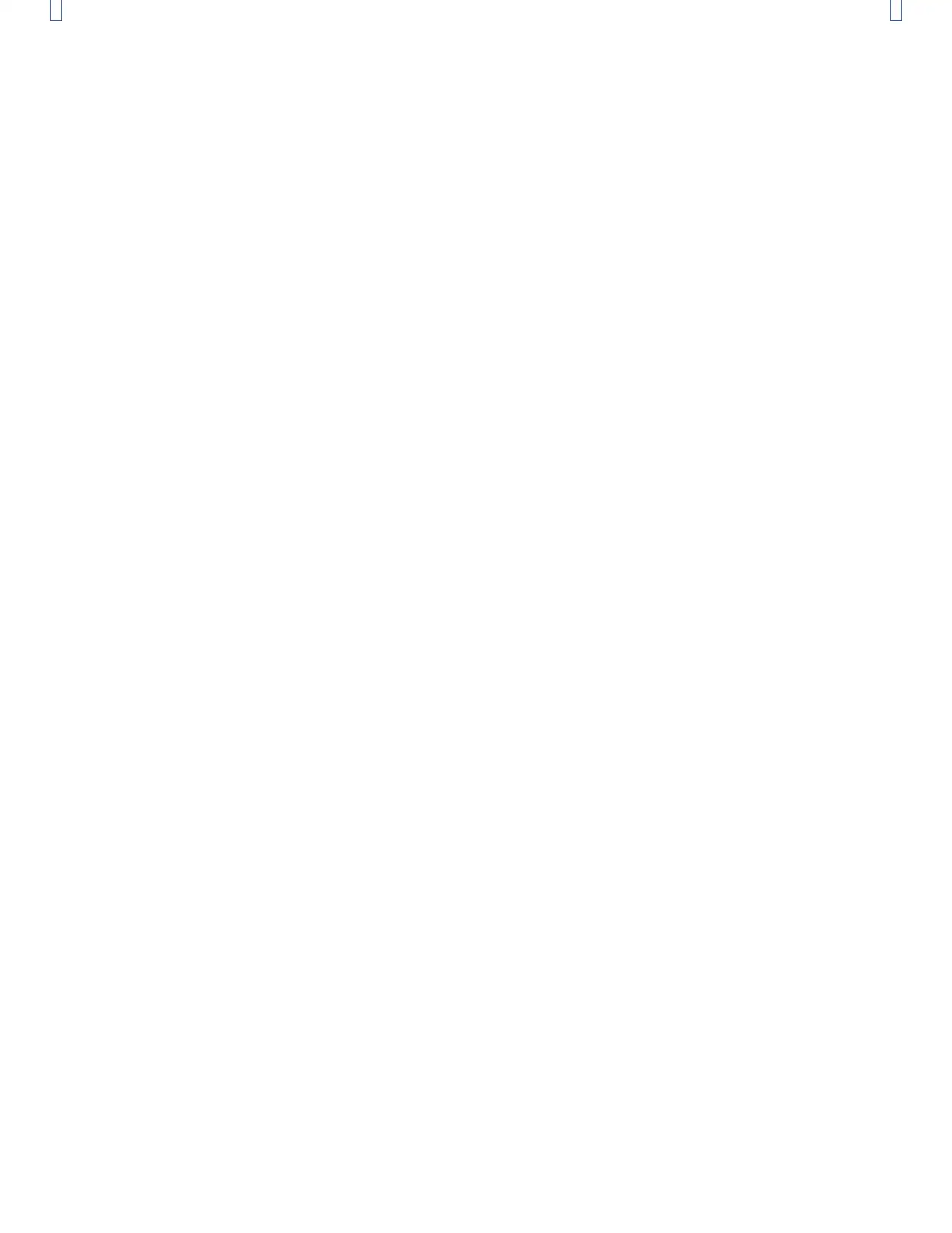
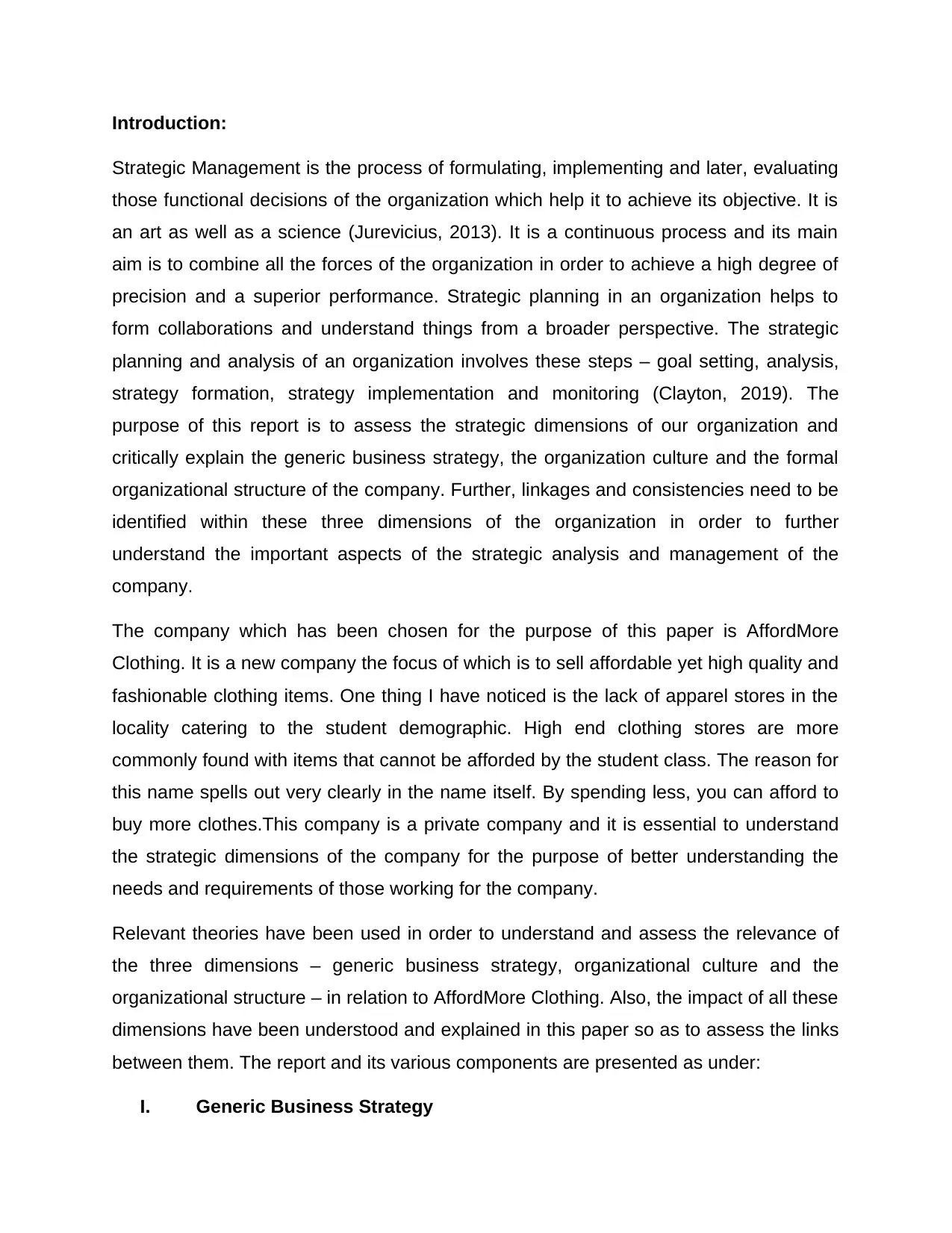
Introduction:
Strategic Management is the process of formulating, implementing and later, evaluating
those functional decisions of the organization which help it to achieve its objective. It is
an art as well as a science (Jurevicius, 2013). It is a continuous process and its main
aim is to combine all the forces of the organization in order to achieve a high degree of
precision and a superior performance. Strategic planning in an organization helps to
form collaborations and understand things from a broader perspective. The strategic
planning and analysis of an organization involves these steps – goal setting, analysis,
strategy formation, strategy implementation and monitoring (Clayton, 2019). The
purpose of this report is to assess the strategic dimensions of our organization and
critically explain the generic business strategy, the organization culture and the formal
organizational structure of the company. Further, linkages and consistencies need to be
identified within these three dimensions of the organization in order to further
understand the important aspects of the strategic analysis and management of the
company.
The company which has been chosen for the purpose of this paper is AffordMore
Clothing. It is a new company the focus of which is to sell affordable yet high quality and
fashionable clothing items. One thing I have noticed is the lack of apparel stores in the
locality catering to the student demographic. High end clothing stores are more
commonly found with items that cannot be afforded by the student class. The reason for
this name spells out very clearly in the name itself. By spending less, you can afford to
buy more clothes.This company is a private company and it is essential to understand
the strategic dimensions of the company for the purpose of better understanding the
needs and requirements of those working for the company.
Relevant theories have been used in order to understand and assess the relevance of
the three dimensions – generic business strategy, organizational culture and the
organizational structure – in relation to AffordMore Clothing. Also, the impact of all these
dimensions have been understood and explained in this paper so as to assess the links
between them. The report and its various components are presented as under:
I. Generic Business Strategy
Strategic Management is the process of formulating, implementing and later, evaluating
those functional decisions of the organization which help it to achieve its objective. It is
an art as well as a science (Jurevicius, 2013). It is a continuous process and its main
aim is to combine all the forces of the organization in order to achieve a high degree of
precision and a superior performance. Strategic planning in an organization helps to
form collaborations and understand things from a broader perspective. The strategic
planning and analysis of an organization involves these steps – goal setting, analysis,
strategy formation, strategy implementation and monitoring (Clayton, 2019). The
purpose of this report is to assess the strategic dimensions of our organization and
critically explain the generic business strategy, the organization culture and the formal
organizational structure of the company. Further, linkages and consistencies need to be
identified within these three dimensions of the organization in order to further
understand the important aspects of the strategic analysis and management of the
company.
The company which has been chosen for the purpose of this paper is AffordMore
Clothing. It is a new company the focus of which is to sell affordable yet high quality and
fashionable clothing items. One thing I have noticed is the lack of apparel stores in the
locality catering to the student demographic. High end clothing stores are more
commonly found with items that cannot be afforded by the student class. The reason for
this name spells out very clearly in the name itself. By spending less, you can afford to
buy more clothes.This company is a private company and it is essential to understand
the strategic dimensions of the company for the purpose of better understanding the
needs and requirements of those working for the company.
Relevant theories have been used in order to understand and assess the relevance of
the three dimensions – generic business strategy, organizational culture and the
organizational structure – in relation to AffordMore Clothing. Also, the impact of all these
dimensions have been understood and explained in this paper so as to assess the links
between them. The report and its various components are presented as under:
I. Generic Business Strategy
⊘ This is a preview!⊘
Do you want full access?
Subscribe today to unlock all pages.

Trusted by 1+ million students worldwide
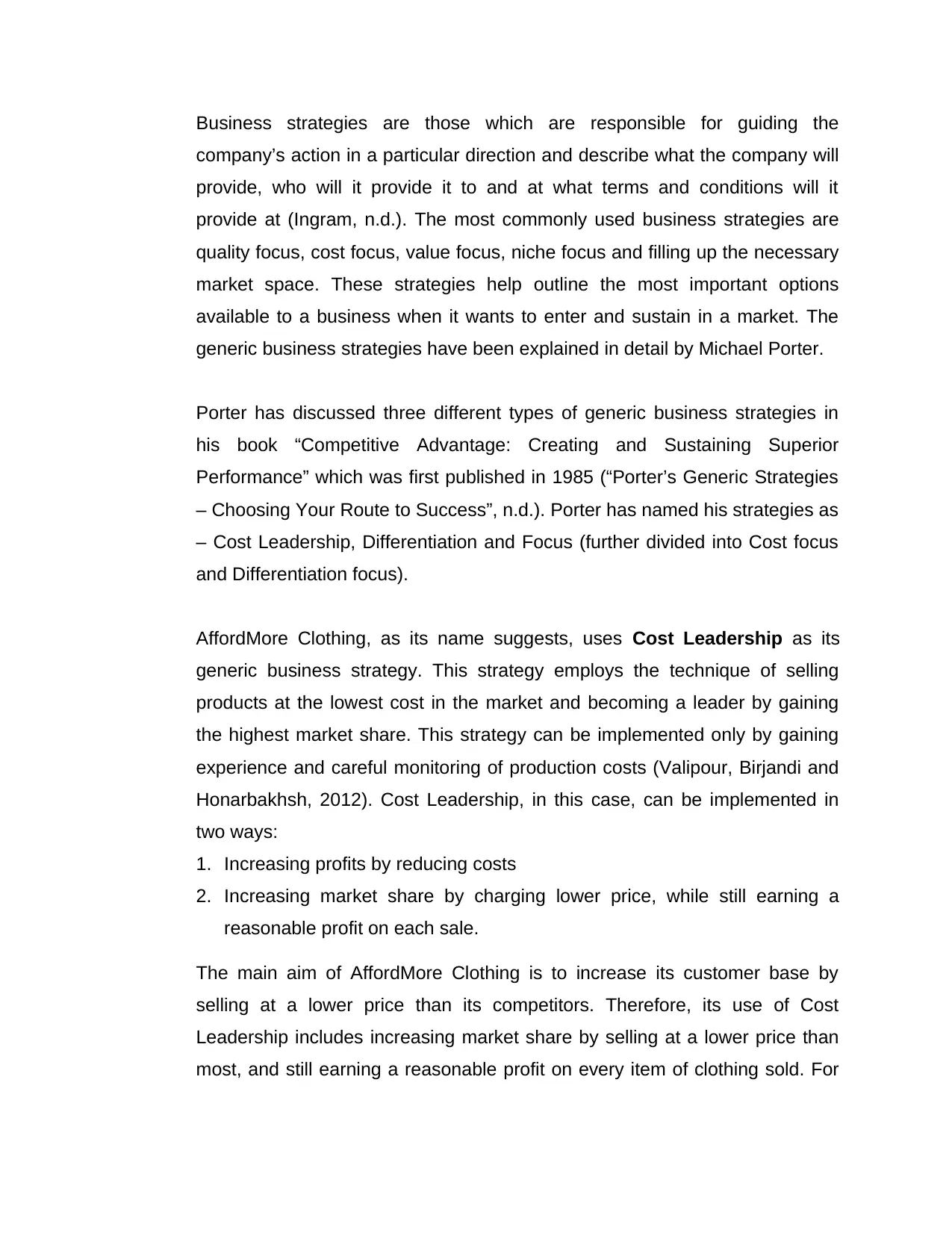
Business strategies are those which are responsible for guiding the
company’s action in a particular direction and describe what the company will
provide, who will it provide it to and at what terms and conditions will it
provide at (Ingram, n.d.). The most commonly used business strategies are
quality focus, cost focus, value focus, niche focus and filling up the necessary
market space. These strategies help outline the most important options
available to a business when it wants to enter and sustain in a market. The
generic business strategies have been explained in detail by Michael Porter.
Porter has discussed three different types of generic business strategies in
his book “Competitive Advantage: Creating and Sustaining Superior
Performance” which was first published in 1985 (“Porter’s Generic Strategies
– Choosing Your Route to Success”, n.d.). Porter has named his strategies as
– Cost Leadership, Differentiation and Focus (further divided into Cost focus
and Differentiation focus).
AffordMore Clothing, as its name suggests, uses Cost Leadership as its
generic business strategy. This strategy employs the technique of selling
products at the lowest cost in the market and becoming a leader by gaining
the highest market share. This strategy can be implemented only by gaining
experience and careful monitoring of production costs (Valipour, Birjandi and
Honarbakhsh, 2012). Cost Leadership, in this case, can be implemented in
two ways:
1. Increasing profits by reducing costs
2. Increasing market share by charging lower price, while still earning a
reasonable profit on each sale.
The main aim of AffordMore Clothing is to increase its customer base by
selling at a lower price than its competitors. Therefore, its use of Cost
Leadership includes increasing market share by selling at a lower price than
most, and still earning a reasonable profit on every item of clothing sold. For
company’s action in a particular direction and describe what the company will
provide, who will it provide it to and at what terms and conditions will it
provide at (Ingram, n.d.). The most commonly used business strategies are
quality focus, cost focus, value focus, niche focus and filling up the necessary
market space. These strategies help outline the most important options
available to a business when it wants to enter and sustain in a market. The
generic business strategies have been explained in detail by Michael Porter.
Porter has discussed three different types of generic business strategies in
his book “Competitive Advantage: Creating and Sustaining Superior
Performance” which was first published in 1985 (“Porter’s Generic Strategies
– Choosing Your Route to Success”, n.d.). Porter has named his strategies as
– Cost Leadership, Differentiation and Focus (further divided into Cost focus
and Differentiation focus).
AffordMore Clothing, as its name suggests, uses Cost Leadership as its
generic business strategy. This strategy employs the technique of selling
products at the lowest cost in the market and becoming a leader by gaining
the highest market share. This strategy can be implemented only by gaining
experience and careful monitoring of production costs (Valipour, Birjandi and
Honarbakhsh, 2012). Cost Leadership, in this case, can be implemented in
two ways:
1. Increasing profits by reducing costs
2. Increasing market share by charging lower price, while still earning a
reasonable profit on each sale.
The main aim of AffordMore Clothing is to increase its customer base by
selling at a lower price than its competitors. Therefore, its use of Cost
Leadership includes increasing market share by selling at a lower price than
most, and still earning a reasonable profit on every item of clothing sold. For
Paraphrase This Document
Need a fresh take? Get an instant paraphrase of this document with our AI Paraphraser
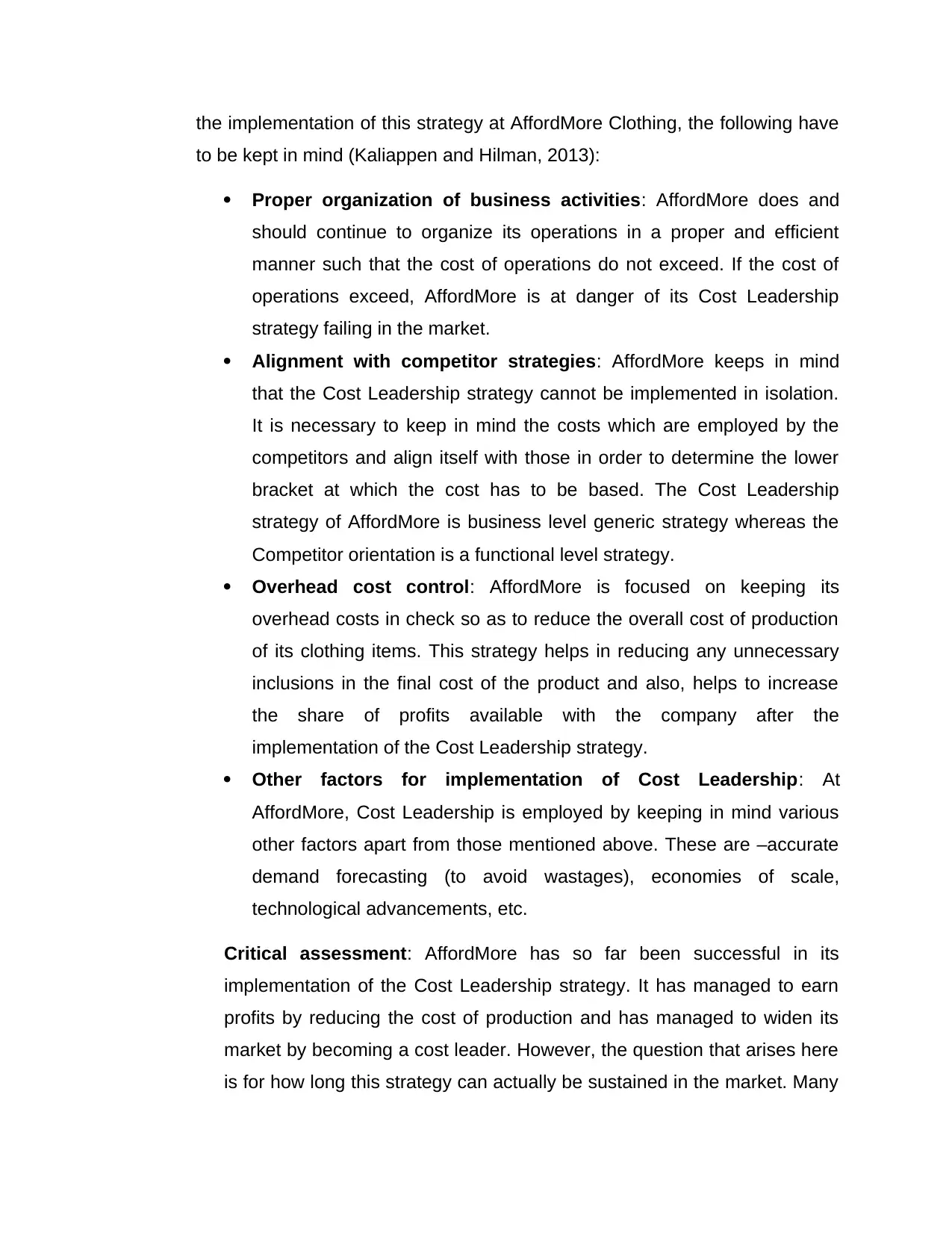
the implementation of this strategy at AffordMore Clothing, the following have
to be kept in mind (Kaliappen and Hilman, 2013):
Proper organization of business activities: AffordMore does and
should continue to organize its operations in a proper and efficient
manner such that the cost of operations do not exceed. If the cost of
operations exceed, AffordMore is at danger of its Cost Leadership
strategy failing in the market.
Alignment with competitor strategies: AffordMore keeps in mind
that the Cost Leadership strategy cannot be implemented in isolation.
It is necessary to keep in mind the costs which are employed by the
competitors and align itself with those in order to determine the lower
bracket at which the cost has to be based. The Cost Leadership
strategy of AffordMore is business level generic strategy whereas the
Competitor orientation is a functional level strategy.
Overhead cost control: AffordMore is focused on keeping its
overhead costs in check so as to reduce the overall cost of production
of its clothing items. This strategy helps in reducing any unnecessary
inclusions in the final cost of the product and also, helps to increase
the share of profits available with the company after the
implementation of the Cost Leadership strategy.
Other factors for implementation of Cost Leadership: At
AffordMore, Cost Leadership is employed by keeping in mind various
other factors apart from those mentioned above. These are –accurate
demand forecasting (to avoid wastages), economies of scale,
technological advancements, etc.
Critical assessment: AffordMore has so far been successful in its
implementation of the Cost Leadership strategy. It has managed to earn
profits by reducing the cost of production and has managed to widen its
market by becoming a cost leader. However, the question that arises here
is for how long this strategy can actually be sustained in the market. Many
to be kept in mind (Kaliappen and Hilman, 2013):
Proper organization of business activities: AffordMore does and
should continue to organize its operations in a proper and efficient
manner such that the cost of operations do not exceed. If the cost of
operations exceed, AffordMore is at danger of its Cost Leadership
strategy failing in the market.
Alignment with competitor strategies: AffordMore keeps in mind
that the Cost Leadership strategy cannot be implemented in isolation.
It is necessary to keep in mind the costs which are employed by the
competitors and align itself with those in order to determine the lower
bracket at which the cost has to be based. The Cost Leadership
strategy of AffordMore is business level generic strategy whereas the
Competitor orientation is a functional level strategy.
Overhead cost control: AffordMore is focused on keeping its
overhead costs in check so as to reduce the overall cost of production
of its clothing items. This strategy helps in reducing any unnecessary
inclusions in the final cost of the product and also, helps to increase
the share of profits available with the company after the
implementation of the Cost Leadership strategy.
Other factors for implementation of Cost Leadership: At
AffordMore, Cost Leadership is employed by keeping in mind various
other factors apart from those mentioned above. These are –accurate
demand forecasting (to avoid wastages), economies of scale,
technological advancements, etc.
Critical assessment: AffordMore has so far been successful in its
implementation of the Cost Leadership strategy. It has managed to earn
profits by reducing the cost of production and has managed to widen its
market by becoming a cost leader. However, the question that arises here
is for how long this strategy can actually be sustained in the market. Many
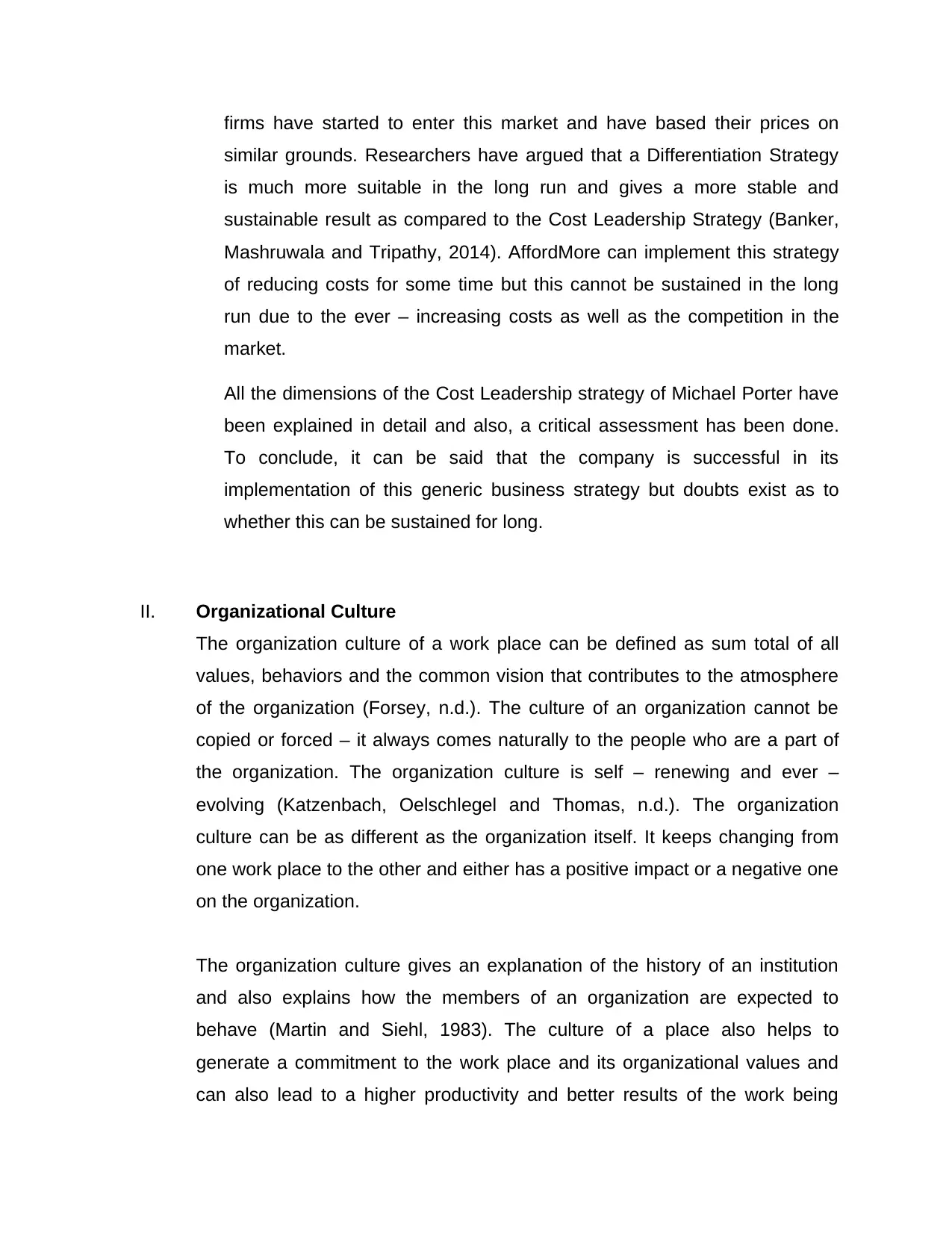
firms have started to enter this market and have based their prices on
similar grounds. Researchers have argued that a Differentiation Strategy
is much more suitable in the long run and gives a more stable and
sustainable result as compared to the Cost Leadership Strategy (Banker,
Mashruwala and Tripathy, 2014). AffordMore can implement this strategy
of reducing costs for some time but this cannot be sustained in the long
run due to the ever – increasing costs as well as the competition in the
market.
All the dimensions of the Cost Leadership strategy of Michael Porter have
been explained in detail and also, a critical assessment has been done.
To conclude, it can be said that the company is successful in its
implementation of this generic business strategy but doubts exist as to
whether this can be sustained for long.
II. Organizational Culture
The organization culture of a work place can be defined as sum total of all
values, behaviors and the common vision that contributes to the atmosphere
of the organization (Forsey, n.d.). The culture of an organization cannot be
copied or forced – it always comes naturally to the people who are a part of
the organization. The organization culture is self – renewing and ever –
evolving (Katzenbach, Oelschlegel and Thomas, n.d.). The organization
culture can be as different as the organization itself. It keeps changing from
one work place to the other and either has a positive impact or a negative one
on the organization.
The organization culture gives an explanation of the history of an institution
and also explains how the members of an organization are expected to
behave (Martin and Siehl, 1983). The culture of a place also helps to
generate a commitment to the work place and its organizational values and
can also lead to a higher productivity and better results of the work being
similar grounds. Researchers have argued that a Differentiation Strategy
is much more suitable in the long run and gives a more stable and
sustainable result as compared to the Cost Leadership Strategy (Banker,
Mashruwala and Tripathy, 2014). AffordMore can implement this strategy
of reducing costs for some time but this cannot be sustained in the long
run due to the ever – increasing costs as well as the competition in the
market.
All the dimensions of the Cost Leadership strategy of Michael Porter have
been explained in detail and also, a critical assessment has been done.
To conclude, it can be said that the company is successful in its
implementation of this generic business strategy but doubts exist as to
whether this can be sustained for long.
II. Organizational Culture
The organization culture of a work place can be defined as sum total of all
values, behaviors and the common vision that contributes to the atmosphere
of the organization (Forsey, n.d.). The culture of an organization cannot be
copied or forced – it always comes naturally to the people who are a part of
the organization. The organization culture is self – renewing and ever –
evolving (Katzenbach, Oelschlegel and Thomas, n.d.). The organization
culture can be as different as the organization itself. It keeps changing from
one work place to the other and either has a positive impact or a negative one
on the organization.
The organization culture gives an explanation of the history of an institution
and also explains how the members of an organization are expected to
behave (Martin and Siehl, 1983). The culture of a place also helps to
generate a commitment to the work place and its organizational values and
can also lead to a higher productivity and better results of the work being
⊘ This is a preview!⊘
Do you want full access?
Subscribe today to unlock all pages.

Trusted by 1+ million students worldwide
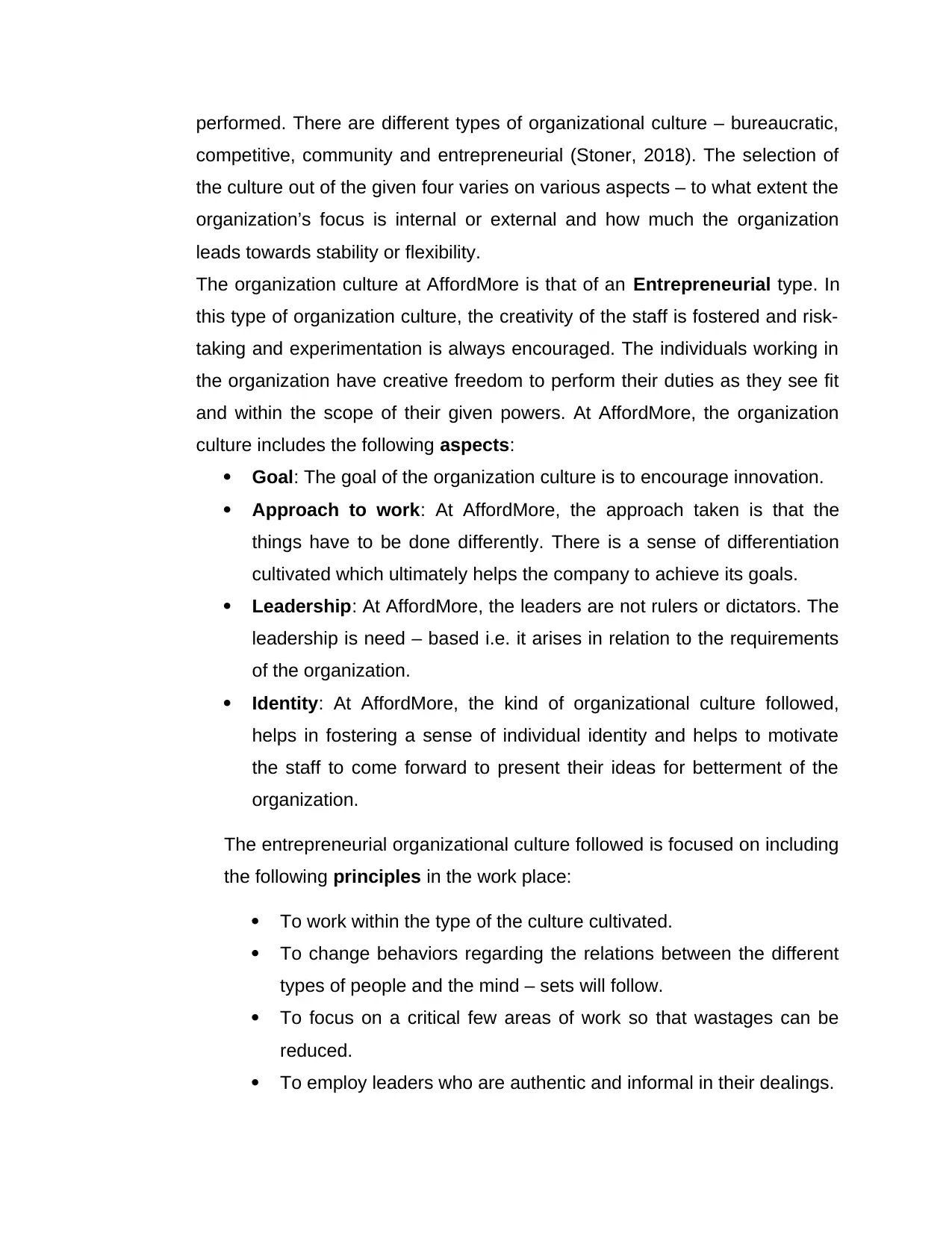
performed. There are different types of organizational culture – bureaucratic,
competitive, community and entrepreneurial (Stoner, 2018). The selection of
the culture out of the given four varies on various aspects – to what extent the
organization’s focus is internal or external and how much the organization
leads towards stability or flexibility.
The organization culture at AffordMore is that of an Entrepreneurial type. In
this type of organization culture, the creativity of the staff is fostered and risk-
taking and experimentation is always encouraged. The individuals working in
the organization have creative freedom to perform their duties as they see fit
and within the scope of their given powers. At AffordMore, the organization
culture includes the following aspects:
Goal: The goal of the organization culture is to encourage innovation.
Approach to work: At AffordMore, the approach taken is that the
things have to be done differently. There is a sense of differentiation
cultivated which ultimately helps the company to achieve its goals.
Leadership: At AffordMore, the leaders are not rulers or dictators. The
leadership is need – based i.e. it arises in relation to the requirements
of the organization.
Identity: At AffordMore, the kind of organizational culture followed,
helps in fostering a sense of individual identity and helps to motivate
the staff to come forward to present their ideas for betterment of the
organization.
The entrepreneurial organizational culture followed is focused on including
the following principles in the work place:
To work within the type of the culture cultivated.
To change behaviors regarding the relations between the different
types of people and the mind – sets will follow.
To focus on a critical few areas of work so that wastages can be
reduced.
To employ leaders who are authentic and informal in their dealings.
competitive, community and entrepreneurial (Stoner, 2018). The selection of
the culture out of the given four varies on various aspects – to what extent the
organization’s focus is internal or external and how much the organization
leads towards stability or flexibility.
The organization culture at AffordMore is that of an Entrepreneurial type. In
this type of organization culture, the creativity of the staff is fostered and risk-
taking and experimentation is always encouraged. The individuals working in
the organization have creative freedom to perform their duties as they see fit
and within the scope of their given powers. At AffordMore, the organization
culture includes the following aspects:
Goal: The goal of the organization culture is to encourage innovation.
Approach to work: At AffordMore, the approach taken is that the
things have to be done differently. There is a sense of differentiation
cultivated which ultimately helps the company to achieve its goals.
Leadership: At AffordMore, the leaders are not rulers or dictators. The
leadership is need – based i.e. it arises in relation to the requirements
of the organization.
Identity: At AffordMore, the kind of organizational culture followed,
helps in fostering a sense of individual identity and helps to motivate
the staff to come forward to present their ideas for betterment of the
organization.
The entrepreneurial organizational culture followed is focused on including
the following principles in the work place:
To work within the type of the culture cultivated.
To change behaviors regarding the relations between the different
types of people and the mind – sets will follow.
To focus on a critical few areas of work so that wastages can be
reduced.
To employ leaders who are authentic and informal in their dealings.
Paraphrase This Document
Need a fresh take? Get an instant paraphrase of this document with our AI Paraphraser
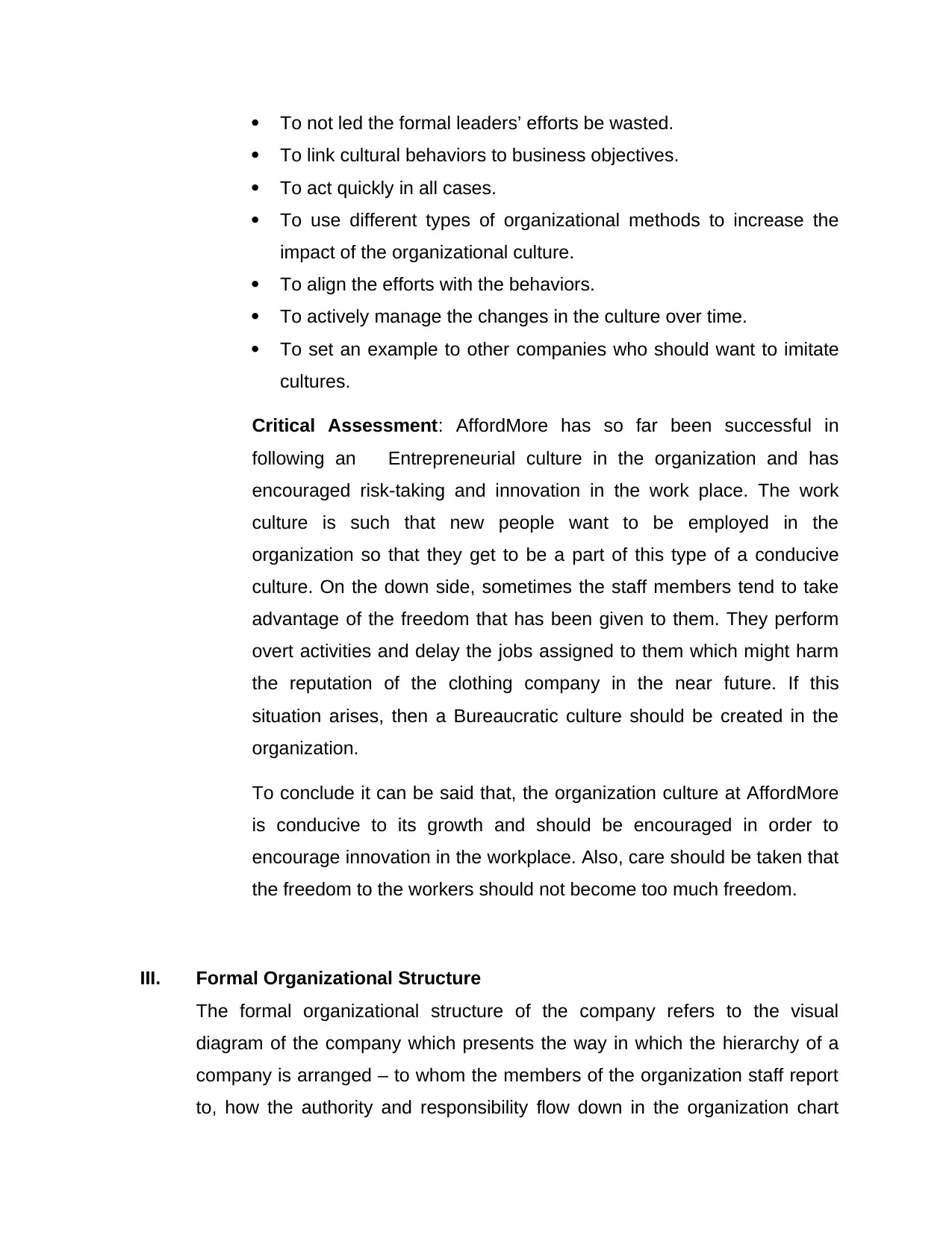
To not led the formal leaders’ efforts be wasted.
To link cultural behaviors to business objectives.
To act quickly in all cases.
To use different types of organizational methods to increase the
impact of the organizational culture.
To align the efforts with the behaviors.
To actively manage the changes in the culture over time.
To set an example to other companies who should want to imitate
cultures.
Critical Assessment: AffordMore has so far been successful in
following an Entrepreneurial culture in the organization and has
encouraged risk-taking and innovation in the work place. The work
culture is such that new people want to be employed in the
organization so that they get to be a part of this type of a conducive
culture. On the down side, sometimes the staff members tend to take
advantage of the freedom that has been given to them. They perform
overt activities and delay the jobs assigned to them which might harm
the reputation of the clothing company in the near future. If this
situation arises, then a Bureaucratic culture should be created in the
organization.
To conclude it can be said that, the organization culture at AffordMore
is conducive to its growth and should be encouraged in order to
encourage innovation in the workplace. Also, care should be taken that
the freedom to the workers should not become too much freedom.
III. Formal Organizational Structure
The formal organizational structure of the company refers to the visual
diagram of the company which presents the way in which the hierarchy of a
company is arranged – to whom the members of the organization staff report
to, how the authority and responsibility flow down in the organization chart
To link cultural behaviors to business objectives.
To act quickly in all cases.
To use different types of organizational methods to increase the
impact of the organizational culture.
To align the efforts with the behaviors.
To actively manage the changes in the culture over time.
To set an example to other companies who should want to imitate
cultures.
Critical Assessment: AffordMore has so far been successful in
following an Entrepreneurial culture in the organization and has
encouraged risk-taking and innovation in the work place. The work
culture is such that new people want to be employed in the
organization so that they get to be a part of this type of a conducive
culture. On the down side, sometimes the staff members tend to take
advantage of the freedom that has been given to them. They perform
overt activities and delay the jobs assigned to them which might harm
the reputation of the clothing company in the near future. If this
situation arises, then a Bureaucratic culture should be created in the
organization.
To conclude it can be said that, the organization culture at AffordMore
is conducive to its growth and should be encouraged in order to
encourage innovation in the workplace. Also, care should be taken that
the freedom to the workers should not become too much freedom.
III. Formal Organizational Structure
The formal organizational structure of the company refers to the visual
diagram of the company which presents the way in which the hierarchy of a
company is arranged – to whom the members of the organization staff report
to, how the authority and responsibility flow down in the organization chart
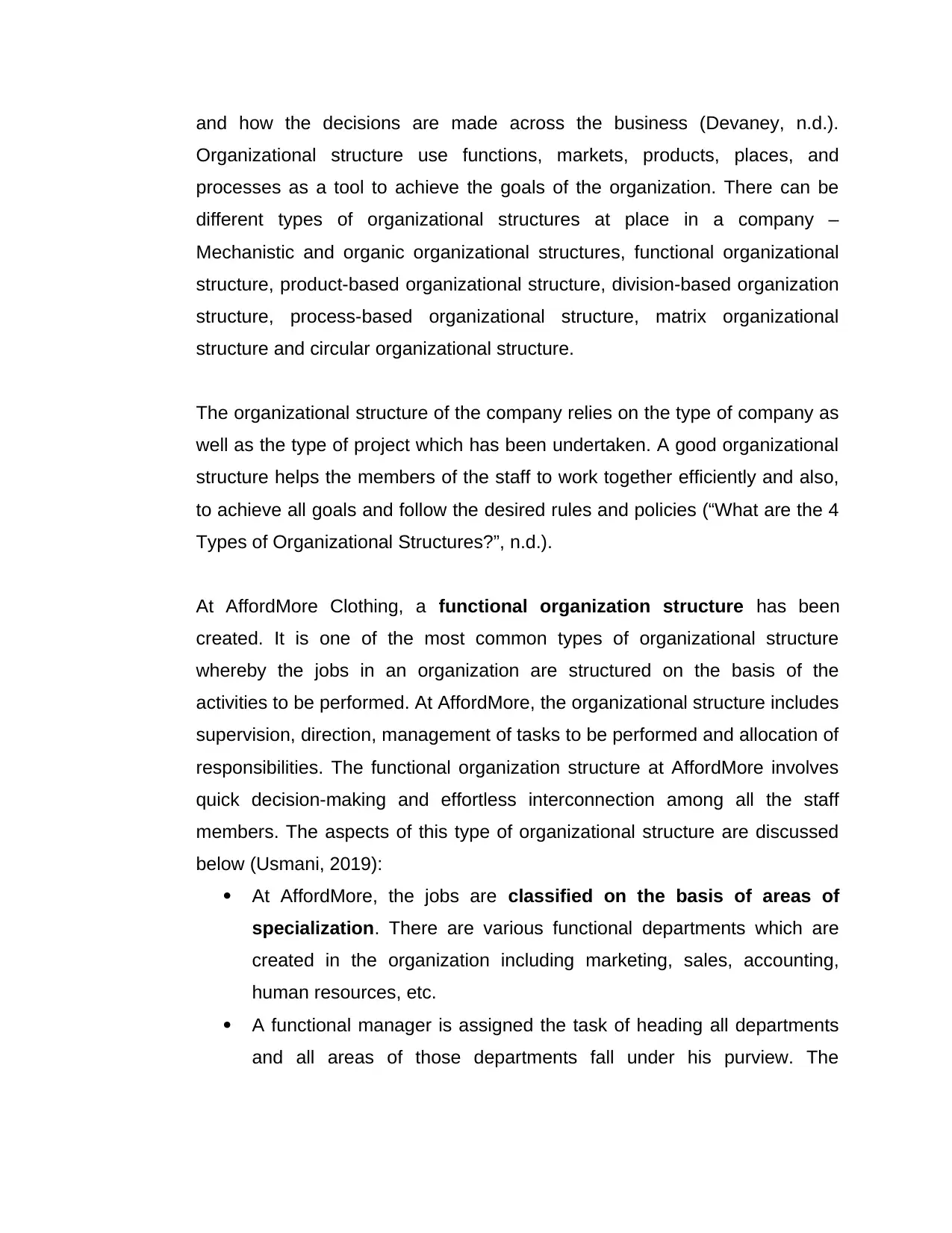
and how the decisions are made across the business (Devaney, n.d.).
Organizational structure use functions, markets, products, places, and
processes as a tool to achieve the goals of the organization. There can be
different types of organizational structures at place in a company –
Mechanistic and organic organizational structures, functional organizational
structure, product-based organizational structure, division-based organization
structure, process-based organizational structure, matrix organizational
structure and circular organizational structure.
The organizational structure of the company relies on the type of company as
well as the type of project which has been undertaken. A good organizational
structure helps the members of the staff to work together efficiently and also,
to achieve all goals and follow the desired rules and policies (“What are the 4
Types of Organizational Structures?”, n.d.).
At AffordMore Clothing, a functional organization structure has been
created. It is one of the most common types of organizational structure
whereby the jobs in an organization are structured on the basis of the
activities to be performed. At AffordMore, the organizational structure includes
supervision, direction, management of tasks to be performed and allocation of
responsibilities. The functional organization structure at AffordMore involves
quick decision-making and effortless interconnection among all the staff
members. The aspects of this type of organizational structure are discussed
below (Usmani, 2019):
At AffordMore, the jobs are classified on the basis of areas of
specialization. There are various functional departments which are
created in the organization including marketing, sales, accounting,
human resources, etc.
A functional manager is assigned the task of heading all departments
and all areas of those departments fall under his purview. The
Organizational structure use functions, markets, products, places, and
processes as a tool to achieve the goals of the organization. There can be
different types of organizational structures at place in a company –
Mechanistic and organic organizational structures, functional organizational
structure, product-based organizational structure, division-based organization
structure, process-based organizational structure, matrix organizational
structure and circular organizational structure.
The organizational structure of the company relies on the type of company as
well as the type of project which has been undertaken. A good organizational
structure helps the members of the staff to work together efficiently and also,
to achieve all goals and follow the desired rules and policies (“What are the 4
Types of Organizational Structures?”, n.d.).
At AffordMore Clothing, a functional organization structure has been
created. It is one of the most common types of organizational structure
whereby the jobs in an organization are structured on the basis of the
activities to be performed. At AffordMore, the organizational structure includes
supervision, direction, management of tasks to be performed and allocation of
responsibilities. The functional organization structure at AffordMore involves
quick decision-making and effortless interconnection among all the staff
members. The aspects of this type of organizational structure are discussed
below (Usmani, 2019):
At AffordMore, the jobs are classified on the basis of areas of
specialization. There are various functional departments which are
created in the organization including marketing, sales, accounting,
human resources, etc.
A functional manager is assigned the task of heading all departments
and all areas of those departments fall under his purview. The
⊘ This is a preview!⊘
Do you want full access?
Subscribe today to unlock all pages.

Trusted by 1+ million students worldwide
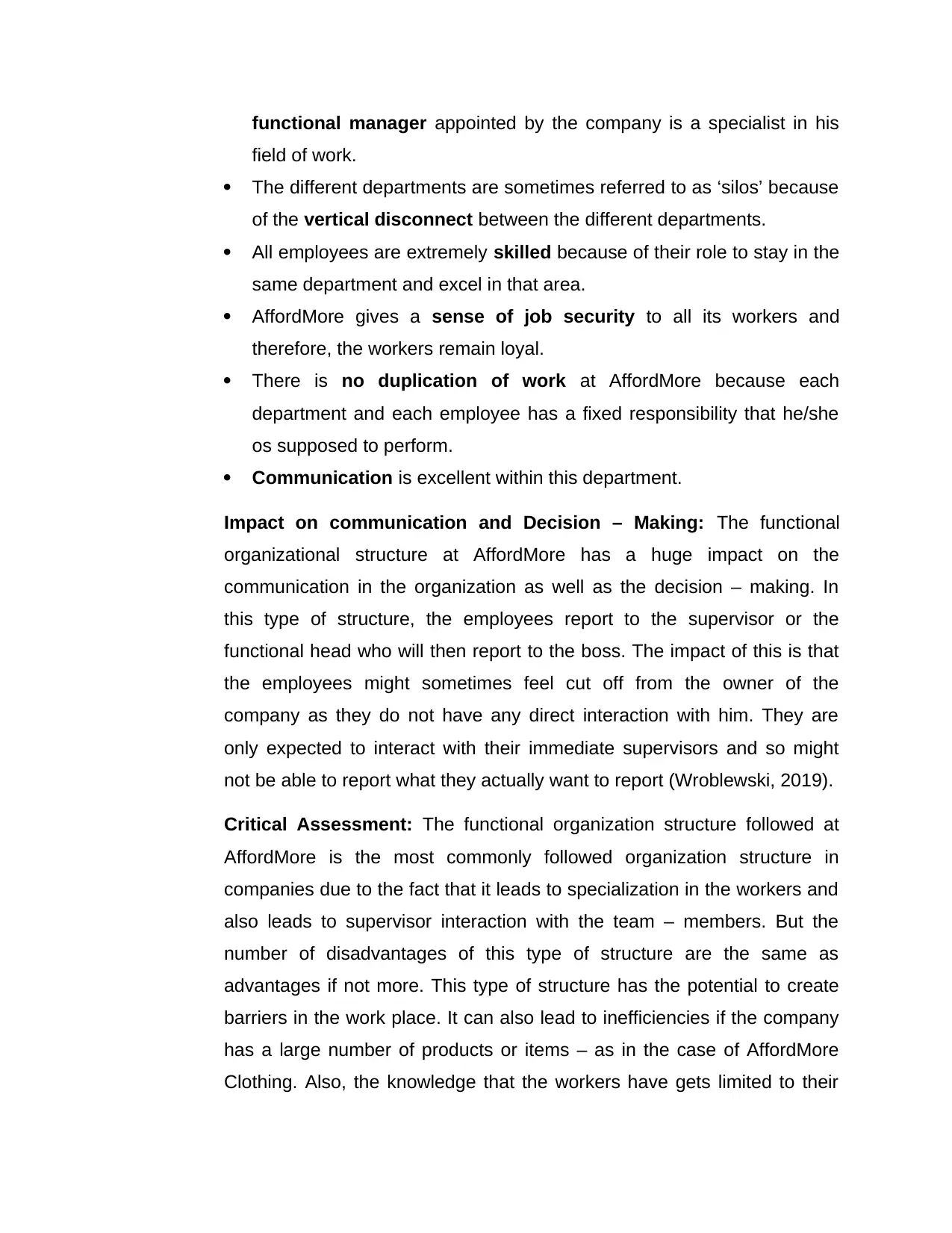
functional manager appointed by the company is a specialist in his
field of work.
The different departments are sometimes referred to as ‘silos’ because
of the vertical disconnect between the different departments.
All employees are extremely skilled because of their role to stay in the
same department and excel in that area.
AffordMore gives a sense of job security to all its workers and
therefore, the workers remain loyal.
There is no duplication of work at AffordMore because each
department and each employee has a fixed responsibility that he/she
os supposed to perform.
Communication is excellent within this department.
Impact on communication and Decision – Making: The functional
organizational structure at AffordMore has a huge impact on the
communication in the organization as well as the decision – making. In
this type of structure, the employees report to the supervisor or the
functional head who will then report to the boss. The impact of this is that
the employees might sometimes feel cut off from the owner of the
company as they do not have any direct interaction with him. They are
only expected to interact with their immediate supervisors and so might
not be able to report what they actually want to report (Wroblewski, 2019).
Critical Assessment: The functional organization structure followed at
AffordMore is the most commonly followed organization structure in
companies due to the fact that it leads to specialization in the workers and
also leads to supervisor interaction with the team – members. But the
number of disadvantages of this type of structure are the same as
advantages if not more. This type of structure has the potential to create
barriers in the work place. It can also lead to inefficiencies if the company
has a large number of products or items – as in the case of AffordMore
Clothing. Also, the knowledge that the workers have gets limited to their
field of work.
The different departments are sometimes referred to as ‘silos’ because
of the vertical disconnect between the different departments.
All employees are extremely skilled because of their role to stay in the
same department and excel in that area.
AffordMore gives a sense of job security to all its workers and
therefore, the workers remain loyal.
There is no duplication of work at AffordMore because each
department and each employee has a fixed responsibility that he/she
os supposed to perform.
Communication is excellent within this department.
Impact on communication and Decision – Making: The functional
organizational structure at AffordMore has a huge impact on the
communication in the organization as well as the decision – making. In
this type of structure, the employees report to the supervisor or the
functional head who will then report to the boss. The impact of this is that
the employees might sometimes feel cut off from the owner of the
company as they do not have any direct interaction with him. They are
only expected to interact with their immediate supervisors and so might
not be able to report what they actually want to report (Wroblewski, 2019).
Critical Assessment: The functional organization structure followed at
AffordMore is the most commonly followed organization structure in
companies due to the fact that it leads to specialization in the workers and
also leads to supervisor interaction with the team – members. But the
number of disadvantages of this type of structure are the same as
advantages if not more. This type of structure has the potential to create
barriers in the work place. It can also lead to inefficiencies if the company
has a large number of products or items – as in the case of AffordMore
Clothing. Also, the knowledge that the workers have gets limited to their
Paraphrase This Document
Need a fresh take? Get an instant paraphrase of this document with our AI Paraphraser
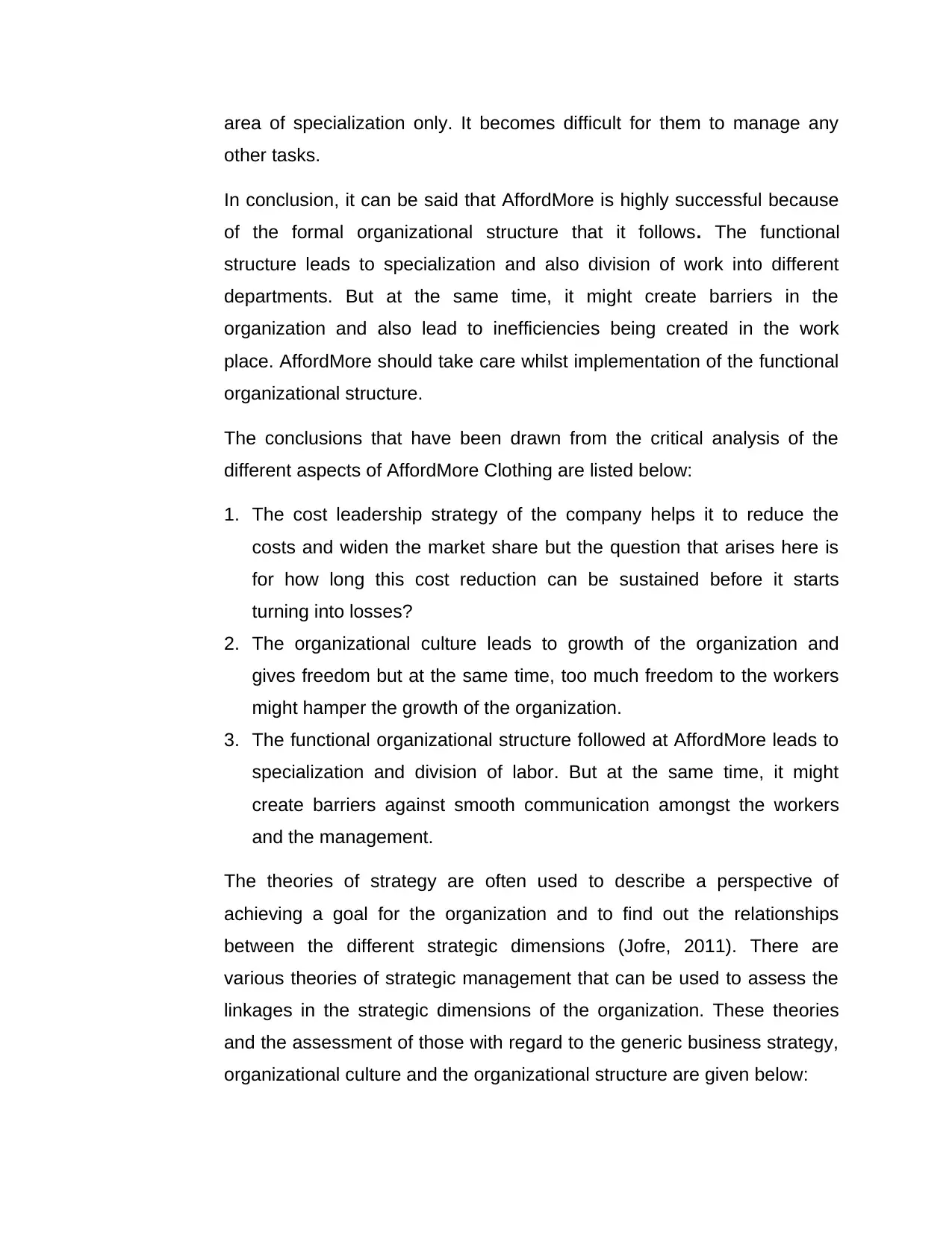
area of specialization only. It becomes difficult for them to manage any
other tasks.
In conclusion, it can be said that AffordMore is highly successful because
of the formal organizational structure that it follows. The functional
structure leads to specialization and also division of work into different
departments. But at the same time, it might create barriers in the
organization and also lead to inefficiencies being created in the work
place. AffordMore should take care whilst implementation of the functional
organizational structure.
The conclusions that have been drawn from the critical analysis of the
different aspects of AffordMore Clothing are listed below:
1. The cost leadership strategy of the company helps it to reduce the
costs and widen the market share but the question that arises here is
for how long this cost reduction can be sustained before it starts
turning into losses?
2. The organizational culture leads to growth of the organization and
gives freedom but at the same time, too much freedom to the workers
might hamper the growth of the organization.
3. The functional organizational structure followed at AffordMore leads to
specialization and division of labor. But at the same time, it might
create barriers against smooth communication amongst the workers
and the management.
The theories of strategy are often used to describe a perspective of
achieving a goal for the organization and to find out the relationships
between the different strategic dimensions (Jofre, 2011). There are
various theories of strategic management that can be used to assess the
linkages in the strategic dimensions of the organization. These theories
and the assessment of those with regard to the generic business strategy,
organizational culture and the organizational structure are given below:
other tasks.
In conclusion, it can be said that AffordMore is highly successful because
of the formal organizational structure that it follows. The functional
structure leads to specialization and also division of work into different
departments. But at the same time, it might create barriers in the
organization and also lead to inefficiencies being created in the work
place. AffordMore should take care whilst implementation of the functional
organizational structure.
The conclusions that have been drawn from the critical analysis of the
different aspects of AffordMore Clothing are listed below:
1. The cost leadership strategy of the company helps it to reduce the
costs and widen the market share but the question that arises here is
for how long this cost reduction can be sustained before it starts
turning into losses?
2. The organizational culture leads to growth of the organization and
gives freedom but at the same time, too much freedom to the workers
might hamper the growth of the organization.
3. The functional organizational structure followed at AffordMore leads to
specialization and division of labor. But at the same time, it might
create barriers against smooth communication amongst the workers
and the management.
The theories of strategy are often used to describe a perspective of
achieving a goal for the organization and to find out the relationships
between the different strategic dimensions (Jofre, 2011). There are
various theories of strategic management that can be used to assess the
linkages in the strategic dimensions of the organization. These theories
and the assessment of those with regard to the generic business strategy,
organizational culture and the organizational structure are given below:
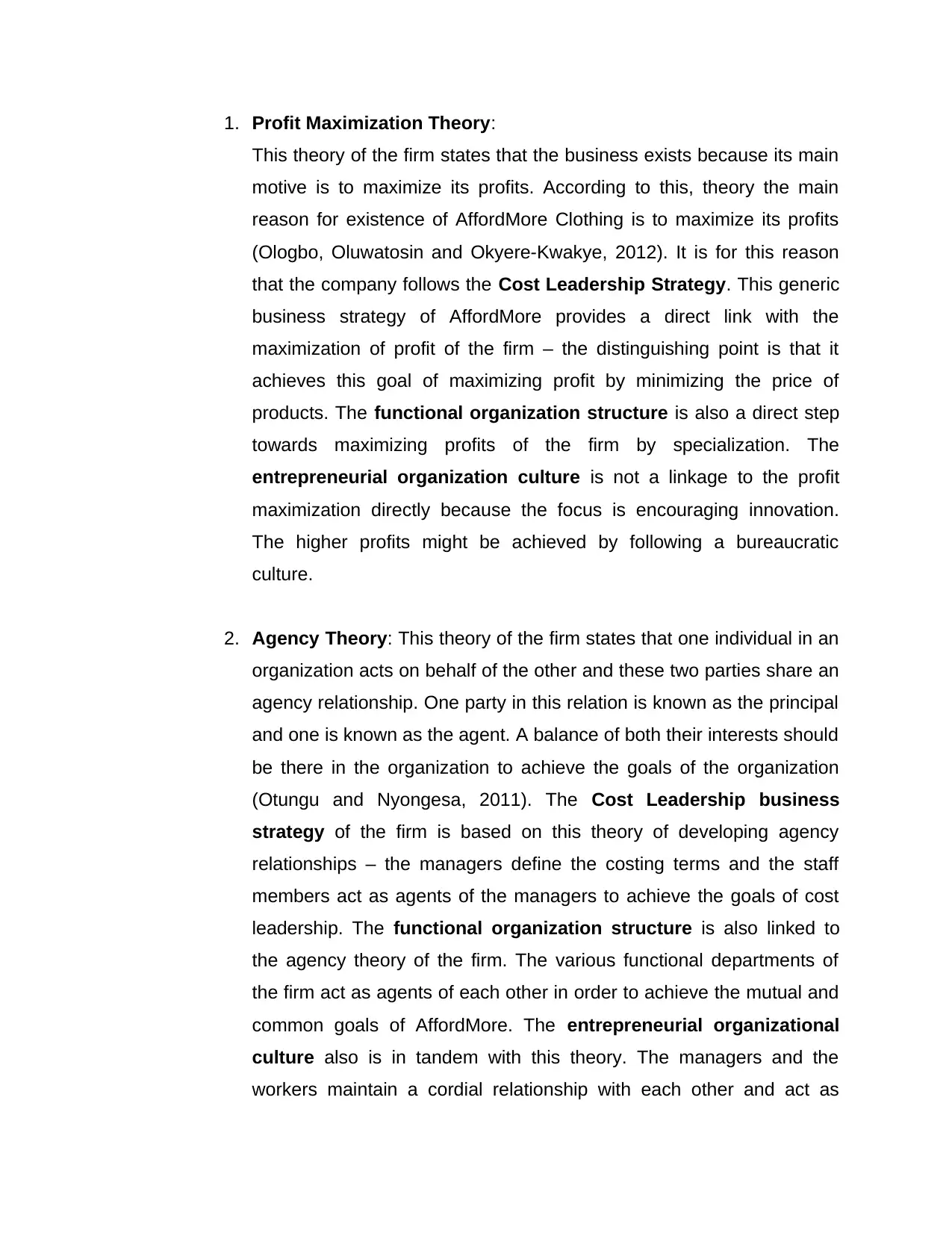
1. Profit Maximization Theory:
This theory of the firm states that the business exists because its main
motive is to maximize its profits. According to this, theory the main
reason for existence of AffordMore Clothing is to maximize its profits
(Ologbo, Oluwatosin and Okyere-Kwakye, 2012). It is for this reason
that the company follows the Cost Leadership Strategy. This generic
business strategy of AffordMore provides a direct link with the
maximization of profit of the firm – the distinguishing point is that it
achieves this goal of maximizing profit by minimizing the price of
products. The functional organization structure is also a direct step
towards maximizing profits of the firm by specialization. The
entrepreneurial organization culture is not a linkage to the profit
maximization directly because the focus is encouraging innovation.
The higher profits might be achieved by following a bureaucratic
culture.
2. Agency Theory: This theory of the firm states that one individual in an
organization acts on behalf of the other and these two parties share an
agency relationship. One party in this relation is known as the principal
and one is known as the agent. A balance of both their interests should
be there in the organization to achieve the goals of the organization
(Otungu and Nyongesa, 2011). The Cost Leadership business
strategy of the firm is based on this theory of developing agency
relationships – the managers define the costing terms and the staff
members act as agents of the managers to achieve the goals of cost
leadership. The functional organization structure is also linked to
the agency theory of the firm. The various functional departments of
the firm act as agents of each other in order to achieve the mutual and
common goals of AffordMore. The entrepreneurial organizational
culture also is in tandem with this theory. The managers and the
workers maintain a cordial relationship with each other and act as
This theory of the firm states that the business exists because its main
motive is to maximize its profits. According to this, theory the main
reason for existence of AffordMore Clothing is to maximize its profits
(Ologbo, Oluwatosin and Okyere-Kwakye, 2012). It is for this reason
that the company follows the Cost Leadership Strategy. This generic
business strategy of AffordMore provides a direct link with the
maximization of profit of the firm – the distinguishing point is that it
achieves this goal of maximizing profit by minimizing the price of
products. The functional organization structure is also a direct step
towards maximizing profits of the firm by specialization. The
entrepreneurial organization culture is not a linkage to the profit
maximization directly because the focus is encouraging innovation.
The higher profits might be achieved by following a bureaucratic
culture.
2. Agency Theory: This theory of the firm states that one individual in an
organization acts on behalf of the other and these two parties share an
agency relationship. One party in this relation is known as the principal
and one is known as the agent. A balance of both their interests should
be there in the organization to achieve the goals of the organization
(Otungu and Nyongesa, 2011). The Cost Leadership business
strategy of the firm is based on this theory of developing agency
relationships – the managers define the costing terms and the staff
members act as agents of the managers to achieve the goals of cost
leadership. The functional organization structure is also linked to
the agency theory of the firm. The various functional departments of
the firm act as agents of each other in order to achieve the mutual and
common goals of AffordMore. The entrepreneurial organizational
culture also is in tandem with this theory. The managers and the
workers maintain a cordial relationship with each other and act as
⊘ This is a preview!⊘
Do you want full access?
Subscribe today to unlock all pages.

Trusted by 1+ million students worldwide
1 out of 18
Related Documents
Your All-in-One AI-Powered Toolkit for Academic Success.
+13062052269
info@desklib.com
Available 24*7 on WhatsApp / Email
![[object Object]](/_next/static/media/star-bottom.7253800d.svg)
Unlock your academic potential
Copyright © 2020–2025 A2Z Services. All Rights Reserved. Developed and managed by ZUCOL.





